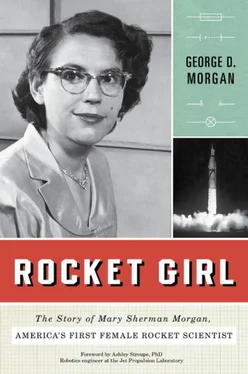To my surprise, however, the Times refused to print the obit. The reason, they said, was that my mother’s life “could not be independently verified.” They said that they had checked the claims in my obit article and could not verify any of them.
They could not verify any of them!
That was when I realized my mother’s numerous accomplishments in the fields of rocketry and aerospace were already turning to dust and were in danger of being lost to history forever. Apparently no one at North American Aviation had been very good at keeping records either, because two years later a former NAA engineer, Robert S. Kraemer, would write a book about the company. He would do it because no one else could. And the reason no one else could write it? According to Kraemer, “The professional historians said there was not enough preserved documentation for them to write a proper history.” [1] Robert S. Kraemer, Rocketdyne: Powering Humans into Space (Reston, VA: AIAA, 2005). Quote is from the liner notes.
After seven years of working on this project, I can tell you this: Robert Kraemer and those “professional historians” were absolutely correct. Historical record keeping in the non-aircraft portions of aerospace has been abysmal.
My mother had been a devout Catholic most of her life, so the funeral service was held at St. John Eudes Catholic Church in Chatsworth, California—just a few miles from the home Mary lived in for almost forty years. Despite the fact I wasn’t a Catholic, the family agreed that I should be the one to deliver the eulogy. It was pretty normal stuff as eulogies go—lots of talk about Jesus, the resurrection, heaven. Blah, blah. After the services, all the attendees—about fifty people—sat down for a sunny, outdoor lunch in the church courtyard.
Lining up at the buffet table, I dished up a plate of food and went looking for an available seat. I noticed that a number of my mother’s former coworkers were gravitating to a table set off from the rest of the group.
My mother had chosen to share very little information about her life as an aerospace engineer. She claimed that her security clearance forbade her from doing so, but we always suspected there was a lot more to it. Long after she retired, and most of her work had been declassified, she continued to enforce those rules of secrecy on herself. She had seen too many of her friends punished over the years for the smallest of infractions. Most of her top secret work had been performed in the 1950s—the McCarthy era—and people were afraid. But long after Senator McCarthy was dead, his ghost continued to haunt my mother’s soul. So when I noticed the NAA engineering group congregating at a single table and talking over the “good old days,” I knew where I had to set my plate. I was eager to hear a few war stories from these men (and they were all men). I took a seat at their table, took a bite out of my sandwich, and quietly listened.
Not more than two minutes went by, however, before I felt a stern tap-tapping on my right hand. I turned to see the face of a very elderly gentleman sitting across the table, his face wrinkled and folded, like those canines that win the “ugliest dog” contests. He stopped tapping my hand, using his bony index finger to point straight at my nose. He spoke.
“You need to listen to me, young man.”
“Yes, sir.”
“My name is Walter. I knew your mother. I worked with her. I’m going to tell you something about her you probably don’t know. Listen carefully.”
“I’m listening.” That was the truth.
He looked left and right, as if checking for FBI surveillance, then stared though my body like it was made of glass.
“In 1957, your mother single-handedly saved America’s space program,” he said, “and nobody knows about it but a handful of old men.” [2] Walter Unterberg, interview with the author, August 10, 2004.
“Hm. Okay.”
“You need to tell her story,” he said. “You need to let people know the truth. Don’t let her die nameless.”
That’s when I remembered: the monthly bridge games.
As a young boy, some of my earliest memories were the bridge tournaments hosted in our Reseda, California, home by my parents. At that time, they were both working for North American Aviation—the forerunner of Rocketdyne. It was the place where they had met. Marrying my mother was no small competitive feat for my father, since she was, as I’ve said, the only woman out of nine hundred engineers. Once a month, about a dozen of those engineers and their spouses would gather at our home to socialize around the card tables. I would walk amongst those tables, small and anonymous, listening to phrases such as, “Two spades,” “Three hearts,” and “We had a fire on the test stand today.” Walter, I now remembered, was one of those bridge-playing engineers.
As he began eating his lunch, I told Walter how I had been unable to convince the Los Angeles Times to publish her obituary. He nodded understandingly.
“To get a large city paper to publish an obit the deceased has to be famous—something your mother was not.”
Despite being a pioneer in the all-male world of aerospace engineering, and despite a long résumé of important and historical accomplishments, Mary had worked hard at not being famous.
“I do not want to see my name in print. You will not write articles about me—not while I am alive.”
Those were my mother’s words to me just after her eightieth birthday when I had the temerity to suggest it would be a good idea if I wrote a magazine article about her historic contributions to American rocketry. When I pressed the issue further she became belligerent, even angry. This was a woman who cared nothing for notoriety, a true anachronism in today’s celebrity-obsessed culture. Mary Sherman Morgan was a woman who shunned publicity and valued her privacy more than life itself. She hated celebrity and detested those who sought after it. To put it another way, she was the exact opposite of that avid publicity hound Wernher von Braun.
Humility, however, has a downside; its practitioners can be lost to history, no matter how great their accomplishments. My final phone conversation with the editor of the Los Angeles Times obituary department grew heated as she continued to refuse to publish my mother’s obit. When the argument reached a red-faced crescendo, and she continued to be obstinate, I threatened to take some kind of action.
She replied, “What are you going to do, Mr. Morgan—sue us?”
“Oh, no. I’m going to do something much worse than sue you,” I said. “I’m going to write a play.”
I hung up the phone and immediately opened my laptop. Through the magic of theater, I decided, I would accomplish what history, the army, NASA, the media, and my own mother had refused to do: I would write a play and use it to bring Mary Sherman Morgan’s accomplishments into the light of day.
This self-imposed assignment quickly turned into a journey—a journey that would take me to many places as I played detective, tracking down the small number of former coworkers who were still alive. They were all retired, of course—some for decades. When I told them about what I was doing, they were unanimous in their desire to help.
You need to tell her story. You need to let people know the truth. Don’t let her die nameless.
In November 2008, the play Rocket Girl opened at Caltech’s 400-seat Ramo Auditorium, playing to large, enthusiastic audiences. At the end of each performance, mothers and their daughters would come up to me and tell me how inspiring the play had been for them. By the time the curtain closed on the night of our last performance, hundreds of websites across the Internet spectrum were reporting, talking, and blogging about Mary Sherman Morgan. Mary became the subject of a history fair exhibit by a high-school student in Maryland (the young girl won the state championship with it), a docent at Cape Canaveral began incorporating my mother’s story into the official tour guide spiel, and theaters around the country began inquiring about producing the play. And even though the Los Angeles Times still refused to publish her obituary, Mary’s name became known to millions almost overnight.
Читать дальше












